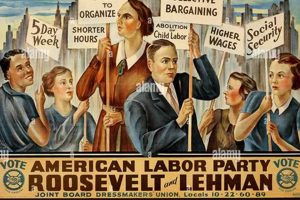These antique advertising displays are pictorial representations used to promote tobacco products, primarily cigars, during the late 19th and early 20th centuries. Characterized by vibrant colors, ornate typography, and often featuring idealized images of cigar smokers or exotic scenes, these visual marketing tools were ubiquitous in tobacco shops, bars, and public spaces. Examples include lithographic prints showcasing brand names alongside illustrations of affluent gentlemen enjoying cigars, or depictions of Cuban tobacco fields.
Their significance lies in their ability to offer a glimpse into the advertising strategies, artistic trends, and social attitudes of a bygone era. They provide insights into the historical marketing of tobacco, demonstrating how companies sought to create aspirational lifestyles around cigar consumption. Furthermore, these items serve as tangible artifacts of printing techniques and graphic design from that period, making them valuable resources for researchers and collectors interested in social history, art history, and advertising history. The preservation of such pieces allows for the continued understanding of cultural values associated with leisure and luxury.
The subsequent sections will delve into the specific artistic styles employed, the prominent artists and printing houses involved in their creation, and the factors influencing their collectibility and value in the modern market. Analysis of these aspects offers a deeper understanding of the enduring appeal and historical importance of these advertising artifacts.
Collecting and Preserving Vintage Cigar Posters
The acquisition and maintenance of antique advertising displays related to tobacco require careful consideration to ensure both preservation and investment value. Proper handling and storage are paramount.
Tip 1: Authentication is Crucial: Prior to purchase, diligently research the sellers reputation and seek expert authentication. Forgeries and reproductions are prevalent in the market. Examine printing techniques, paper quality, and any watermarks to assess originality. Cross-reference with known examples documented in reputable catalogs or archives.
Tip 2: Assess Condition Thoroughly: Evaluate the posters condition under proper lighting. Examine for fading, tears, stains, foxing (brown spots), and any signs of restoration. These flaws significantly impact the poster’s value. Note that professional restoration can enhance appearance but must be documented and should not compromise the original artwork.
Tip 3: Optimal Storage is Essential: Store the poster flat, ideally in archival-quality sleeves or folders, and within acid-free materials. Control the environments temperature and humidity to prevent deterioration. Avoid direct sunlight, which causes fading. Framing with UV-protective glass is recommended for display purposes.
Tip 4: Research Artists and Printers: Understanding the artists and printing companies involved in the poster’s creation enhances its value. Notable lithographers like Strobridge & Co. or artists such as Maxfield Parrish contribute to the collectibility. Knowledge of their styles and techniques aids in identification and appraisal.
Tip 5: Consider Rarity and Subject Matter: Rarity significantly influences the value. Posters promoting specific brands or depicting unique or culturally significant scenes tend to be more sought after. Evaluate the subject matter in terms of its aesthetic appeal and historical context to gauge its potential desirability among collectors.
Tip 6: Maintain Detailed Records: Document the poster’s provenance, purchase price, condition, and any restoration work undertaken. This documentation serves as proof of ownership and aids in future appraisal or sale. High-resolution photographs are invaluable for insurance purposes and condition tracking.
Tip 7: Professional Cleaning is Recommended: If cleaning is necessary, engage a professional paper conservator. Improper cleaning techniques can irreparably damage the poster. Conservators possess the expertise to safely remove surface dirt and address staining without harming the delicate paper and inks.
Adhering to these guidelines facilitates responsible collecting and ensures that antique advertising materials remain preserved for future generations to appreciate and study. Careful research, preservation, and professional consultation are vital for safeguarding the value and historical integrity of these cultural artifacts.
The subsequent analysis will cover the factors that make them desirable within collecting communities and how market value is driven for these beautiful pieces.
1. Lithographic printing
Lithographic printing was fundamentally integral to the production and dissemination of tobacco advertising displays, particularly during their peak popularity. The process, involving the use of a flat stone or metal plate with a grease-based image, enabled the mass creation of vibrant, detailed posters at a relatively low cost. This cost-effectiveness was crucial for cigar manufacturers seeking to promote their brands widely. The unique ability of lithography to reproduce complex artwork and lettering with high fidelity made it the preferred method for conveying brand imagery and aspirational messages to a broad audience. For example, many posters for brands like “Havana Cigars” and “El Producto” leveraged the subtle tonal gradations and intricate detail achievable through lithography to depict idyllic scenes of tobacco cultivation or refined gentlemen enjoying a smoke, thereby enhancing the perceived value and desirability of the product.
The importance of understanding this connection extends to the evaluation and authentication of such advertising artifacts. The specific characteristics of lithographic printing such as the dot patterns, ink layering, and paper type provide valuable clues about the poster’s origin and age. Collectors and historians use these details to distinguish original prints from later reproductions. For instance, the presence of certain types of paper stock or the use of specific color pigments can indicate the printing period and authenticity. Knowledge of lithographic techniques also informs conservation efforts, guiding appropriate methods for cleaning, preserving, and restoring these fragile items. Improper handling based on a lack of understanding of the original printing process can lead to irreversible damage.
In summary, lithographic printing was not merely a production method but a defining element of tobacco advertising posters. Its capabilities shaped the aesthetic and the reach of cigar brand marketing, and understanding its nuances is crucial for the preservation, authentication, and historical interpretation of these cultural artifacts. Recognizing the symbiotic relationship between lithography and these posters allows for a more informed appreciation of their artistic value and their place within the broader context of advertising history.
2. Tobacco advertising
The symbiotic relationship between tobacco advertising and advertising displays from the cigar industry is defined by the posters’ role as a primary vehicle for disseminating brand messaging. As print media gained prominence, the displays served as a tangible representation of a brand’s identity, conveying not only the product’s name but also the aspirational lifestyle associated with its consumption. The advertising was a visual articulation of the brand’s promise. For instance, an advertising display featuring a distinguished gentleman enjoying a cigar in a luxurious setting aimed to associate the brand with sophistication and success, thereby influencing consumer perception and purchasing decisions. The impact of this form of advertising was amplified by its placement in public spaces, ensuring widespread exposure to the target demographic.
The historical context of tobacco advertising necessitates an understanding of the regulatory environment and societal attitudes prevalent at the time. Prior to restrictions on tobacco advertising, companies engaged in aggressive marketing tactics. The displays reflected this era through depictions that often romanticized smoking or minimized the health risks associated with tobacco use. Analyzing the imagery, slogans, and artistic styles employed in these materials provides valuable insights into the cultural norms and marketing strategies that shaped consumer behavior. The evolution of tobacco advertising, as reflected in these posters, serves as a case study in the interplay between advertising, public health, and regulatory oversight. Furthermore, the specific advertising approach, whether focused on quality, price, or aspirational values, provides a window into the competitive landscape of the cigar industry during a particular period.
In essence, these displays represent more than just advertisements; they are artifacts that encapsulate the evolution of marketing techniques, cultural values, and regulatory frameworks surrounding tobacco use. Their study offers a multifaceted understanding of the historical dynamics that shaped both the cigar industry and the broader landscape of consumer culture. Continued research and preservation of these materials are essential for maintaining a comprehensive record of this complex and often controversial aspect of advertising history.
3. Brand Representation
Brand representation, as manifested in tobacco advertising displays, serves as a visual articulation of a company’s identity, values, and aspirational ideals. These posters function as more than mere advertisements; they encapsulate the essence of a brand and its intended image within the consumer’s mind.
- Visual Identity and Symbolism
The selection of imagery, color palettes, and typography within a display directly contributes to brand recognition and recall. For example, a poster featuring a specific logo, distinctive color scheme, or recurring motif establishes a consistent visual presence for the brand. The use of symbolic elements, such as crests, figures, or scenes, further reinforces the brand’s message, associating it with qualities like luxury, tradition, or sophistication.
- Target Audience Messaging
The portrayal of individuals and lifestyles within a advertising display communicates the brand’s understanding of its target demographic. A poster depicting affluent professionals enjoying cigars in a social setting aims to appeal to consumers who aspire to that lifestyle. The messaging is tailored to resonate with the values, aspirations, and perceived needs of the intended audience, influencing their perception of the brand’s relevance to their own lives.
- Product Attributes and Benefits
These displays often subtly or explicitly highlight key attributes of the product, such as its origin, quality, or unique characteristics. A poster emphasizing the use of Cuban tobacco or the careful craftsmanship involved in cigar production reinforces the brand’s commitment to quality and authenticity. Benefits like relaxation, enjoyment, and social connection are frequently depicted to persuade consumers of the product’s value proposition.
- Competitive Differentiation
Brand representation in tobacco advertising displays serves as a means of distinguishing a brand from its competitors. By emphasizing unique features, superior quality, or a distinct brand personality, posters aim to establish a competitive advantage in the consumer’s mind. For instance, a poster highlighting a brand’s long history or exclusive ingredients seeks to differentiate it from newer or less established alternatives.
These posters, therefore, represent a concentrated effort to craft and communicate a specific brand identity to a target audience. The careful selection of visual elements, messaging, and symbolism collectively contributes to the overall brand representation and influences consumer perception, purchase decisions, and long-term brand loyalty. The study of these displays provides valuable insights into the strategic use of advertising for brand building and the cultural values associated with tobacco consumption during their era of prevalence.
4. Artistic style
The artistic style of vintage cigar posters is inextricably linked to their function as persuasive marketing tools and cultural artifacts. The specific aesthetic choices, from the dominant art movements to the individual artist’s techniques, directly influenced the posters’ effectiveness in attracting attention and shaping perceptions of the product. For example, the Art Nouveau style, characterized by flowing lines, organic motifs, and elegant typography, frequently appeared in posters promoting premium cigar brands. This style conveyed a sense of luxury and sophistication, aligning the product with the broader aesthetic values of the era and appealing to a discerning clientele. Conversely, the bolder, more geometric forms of Art Deco, which emerged later, suggested modernity and progress, potentially targeting a different demographic or emphasizing innovation within the industry.
The practical significance of understanding the artistic style lies in its implications for authentication, valuation, and historical interpretation. Recognizing the stylistic conventions of a particular period or artist can aid in determining a poster’s authenticity, as forgeries often fail to accurately replicate the nuances of original designs. Furthermore, the presence of a recognizable artistic style can influence a poster’s market value, with pieces attributed to renowned artists or exemplifying a significant art movement commanding higher prices. From a historical perspective, the artistic style provides insights into the cultural context surrounding cigar consumption, reflecting prevailing tastes, social attitudes, and the visual language of advertising during that time. The use of idealized imagery, stereotypical representations, or patriotic themes reveals societal norms and the strategies employed to align the product with broader cultural values.
In conclusion, the artistic style of vintage cigar posters is not merely a decorative element but an integral component that shapes their persuasive power, market value, and historical significance. By analyzing the aesthetic choices employed, researchers, collectors, and historians can gain a deeper understanding of the complex interplay between art, commerce, and cultural values in the context of tobacco advertising. The preservation and study of these posters are thus essential for maintaining a comprehensive record of both artistic expression and the evolution of marketing techniques.
5. Social context
The social context surrounding the creation and dissemination of vintage cigar posters is fundamentally intertwined with their meaning and impact. These posters are not merely commercial advertisements; they are cultural artifacts that reflect the societal norms, values, and attitudes of their time. The imagery, themes, and messages depicted in these posters were carefully crafted to resonate with the prevailing social climate and aspirations of potential consumers. For example, posters from the late 19th century often portrayed cigars as symbols of wealth, status, and sophistication, reflecting the aspirational values of a rapidly industrializing society. The prominence of male figures enjoying cigars in these advertisements reveals the social norms surrounding gender roles and the association of cigar smoking with masculinity and leisure. These visual cues served to reinforce and propagate specific social ideals, thereby influencing consumer behavior and shaping cultural perceptions of tobacco use.
Furthermore, the evolution of social attitudes towards tobacco had a direct impact on the content and style of these posters. As public awareness of the health risks associated with smoking grew, and regulations on tobacco advertising tightened, the tone and themes of these posters shifted. The romanticized depictions of smoking gave way to more subtle and indirect forms of promotion. Analyzing these changes in advertising style provides valuable insights into the complex interplay between public health concerns, regulatory interventions, and the evolving social consciousness surrounding tobacco use. Consider the shift from portraying cigars as harmless indulgences to focusing on the social aspects of smoking or emphasizing the craftsmanship and quality of the product. This transition mirrors the broader societal shift in attitudes towards tobacco and its consumption.
In conclusion, understanding the social context is crucial for interpreting the meaning and significance of vintage cigar posters. These posters serve as tangible reminders of a time when tobacco advertising was largely unregulated and social attitudes towards smoking were markedly different. By analyzing the imagery, themes, and messages within these posters, and placing them within their historical and cultural context, it becomes possible to gain a deeper appreciation of the complex relationship between advertising, consumer culture, and societal values. The posters not only document the historical marketing of tobacco products but also reflect the broader social landscape of their era.
6. Rarity factor
The rarity factor exerts a significant influence on the valuation and collectibility of vintage cigar posters. A poster’s scarcity, determined by factors such as limited print runs, historical events, and preservation rates, directly correlates with its desirability among collectors. The cause-and-effect relationship is straightforward: lower availability translates to higher perceived value, assuming other factors like condition and artistic merit are satisfactory. A poster promoting a short-lived brand, or one associated with a specific event or anniversary, will inherently be more uncommon than those from widely marketed, long-established brands. The importance of rarity stems from its role in transforming a common advertisement into a unique artifact, sought after for its historical significance and investment potential. For instance, a poster featuring a now-defunct Cuban cigar brand, printed before the Cuban Revolution and existing in only a handful of documented copies, commands a premium due to its scarcity and historical context. This exemplifies how rarity elevates an item beyond its initial function into a coveted collector’s piece.
The practical significance of understanding the rarity factor extends to informed decision-making in the acquisition and appraisal of such posters. Collectors and dealers must carefully assess the known print history, documented examples, and evidence of destruction or loss. Factors such as wartime paper drives or intentional disposal by businesses can drastically reduce the number of surviving posters, thereby increasing their rarity. Appraisers rely on comprehensive databases and auction records to establish comparable values, adjusting for rarity based on verifiable data. Counterfeiting poses a significant challenge, as unscrupulous individuals may attempt to replicate rare posters, capitalizing on the high demand. Therefore, authentication becomes paramount, often requiring expert analysis of printing techniques, paper composition, and other characteristics unique to the original production period. Without due diligence in assessing rarity, collectors risk overpaying for reproductions or misjudging the potential investment value of their acquisitions.
In summary, the rarity factor is a critical determinant of value and desirability in the market for vintage cigar posters. It acts as a multiplier, amplifying the effects of other attributes like artistic quality and historical relevance. While authentication is crucial in mitigating the risk of fraud, a deep understanding of the factors contributing to rarity allows collectors and dealers to make informed decisions, ensuring the preservation of these unique cultural artifacts and the responsible management of investments. The challenges lie in accurately assessing rarity given incomplete historical records, and in guarding against the ever-present threat of counterfeit items.
7. Collector demand
Collector demand functions as a primary driver in the valuation and preservation of vintage cigar posters, influencing market dynamics and directing collecting trends. Its effects manifest across multiple facets, each contributing uniquely to the overall significance of these historical artifacts.
- Historical Significance and Nostalgia
The historical narrative encapsulated within each poster, combined with a sense of nostalgia for a bygone era, fuels collector interest. The posters serve as tangible connections to a time when cigar smoking held different cultural connotations, evoking memories or imaginations of a specific past. The demand is often higher for posters that depict significant historical events or iconic figures, illustrating a direct correlation between historical relevance and collectibility.
- Aesthetic Appeal and Artistic Value
The artistic merit inherent in these posters, stemming from the lithographic printing techniques, design elements, and the artist’s skill, contributes significantly to collector demand. Posters that showcase exceptional artistry, vibrant colors, or unique graphic design are typically more sought after. The aesthetic appeal aligns with broader collecting interests in vintage advertising art, broadening the potential collector base beyond those specifically interested in tobacco history.
- Condition and Rarity
The physical condition and rarity of a poster are critical determinants of its desirability. Well-preserved posters, free from significant damage or restoration, command higher prices. Rarity, often linked to limited print runs or historical events that reduced survival rates, elevates a poster’s perceived value. The combination of excellent condition and scarcity creates a powerful incentive for collectors, driving competition and pushing prices upward. For example, posters for obscure or short-lived brands are particularly coveted due to their limited availability.
- Investment Potential
The perception of vintage cigar posters as a viable investment contributes to collector demand. As tangible assets with potential for appreciation, these posters attract collectors seeking both enjoyment and financial returns. Market trends, auction results, and expert appraisals influence investment decisions, with some collectors actively pursuing specific posters based on their anticipated future value. This investment-driven demand further supports the preservation and conservation efforts aimed at maintaining the posters’ condition and historical integrity.
In summation, the collective interest in vintage cigar posters is sustained by a confluence of factors, including their historical significance, aesthetic appeal, rarity, and investment potential. Collector demand, in turn, shapes the market dynamics, influencing both the preservation of these artifacts and their economic value within the collecting community.
Frequently Asked Questions
The following addresses common inquiries and clarifies pertinent information regarding antique advertising displays from the cigar industry.
Question 1: What distinguishes an original vintage cigar poster from a modern reproduction?
Original pieces typically exhibit characteristics inherent to early printing processes, such as lithography or letterpress, with unique paper stock, ink composition, and subtle imperfections arising from manual production techniques. Modern reproductions often utilize digital printing methods, resulting in a different visual texture and paper quality. Consulting with an expert in antique prints is advised for authentication.
Question 2: How does condition impact the value of a vintage cigar poster?
Condition significantly influences valuation. Factors such as fading, tears, staining, foxing (brown spots), and evidence of restoration directly affect the poster’s desirability and market price. Posters in excellent, unrestored condition command a premium. Professional restoration, while potentially improving aesthetics, must be carefully documented and may not fully recover the original value.
Question 3: What are some of the key artists or printing houses associated with these displays?
Several prominent lithographers and artists specialized in producing these advertising materials. Notable examples include Strobridge Lithographing Company, H.C. Miner Litho. Co., and artists like Maxfield Parrish, who occasionally contributed to this genre. Researching the artist or printer can provide insights into the poster’s origin and artistic significance.
Question 4: How should these delicate artifacts be properly stored and preserved?
Proper storage is essential for long-term preservation. The artifact should be stored flat, ideally in archival-quality sleeves or folders, utilizing acid-free materials. Maintaining a stable environment with controlled temperature and humidity is crucial. Direct sunlight exposure should be avoided to prevent fading. Framing with UV-protective glass is recommended for display purposes.
Question 5: Are there specific themes or subjects that make these displays particularly valuable?
Posters featuring rare brands, historically significant events, or unique artistic compositions tend to be more valuable. The subject matter should be assessed for its aesthetic appeal, historical context, and cultural relevance. Pieces depicting scenes of cigar production, portraits of notable figures, or patriotic themes often attract considerable interest.
Question 6: Where can reputable authentication and appraisal services for these displays be found?
Reputable auction houses specializing in vintage posters, art galleries with expertise in antique prints, and professional appraisal organizations (such as the Appraisers Association of America) can provide authentication and appraisal services. Verify the credentials and experience of any expert consulted.
Understanding these fundamental aspects is vital for collectors, historians, and anyone interested in appreciating the historical and artistic significance of advertising displays. These insights aid responsible acquisition, preservation, and informed decision-making within the market.
The following sections will delve into the legal and ethical considerations associated with collecting and selling these items.
Conclusion
This exploration has illuminated the multifaceted nature of these relics. They serve not only as historical artifacts, but also as tangible representations of advertising strategies, artistic movements, and societal values prevalent during their era of creation. The assessment of their authenticity, condition, rarity, and artistic merit is crucial for informed acquisition and preservation efforts.
The continued study and responsible stewardship of these displays are essential for maintaining a comprehensive understanding of advertising history, visual culture, and the evolving relationship between commerce and society. Future research should focus on documenting lesser-known artists and printing houses, and exploring the international variations in cigar advertising styles. Their preservation is a testament to an important part of history and culture.







